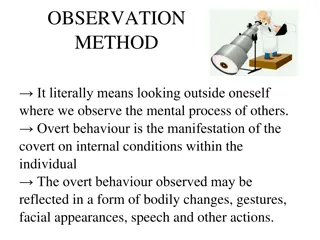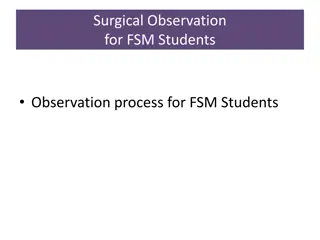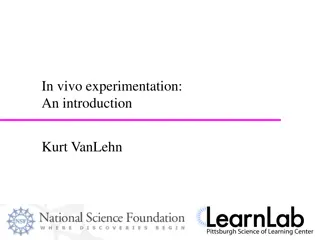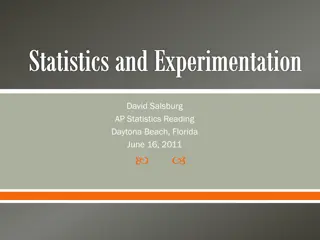Understanding Experiments in Research: Observation vs. Experimentation
Observation and experiments are two crucial methods in research. An observational study involves observing and measuring variables without influencing responses, while an experiment deliberately applies treatments to measure responses. Confounding variables can affect the results, and factors like experimental units, subjects, treatments, and levels play key roles in experimental design. This content explains the differences between observation and experimentation, discusses confounding variables, and outlines the components of experimental studies using examples. It also illustrates how to set up an experiment to study the effects of fertilizer and water on tomato plant productivity.
Download Presentation

Please find below an Image/Link to download the presentation.
The content on the website is provided AS IS for your information and personal use only. It may not be sold, licensed, or shared on other websites without obtaining consent from the author. Download presentation by click this link. If you encounter any issues during the download, it is possible that the publisher has removed the file from their server.
E N D
Presentation Transcript
Observation versus Experiment Observation versus Experiment An observational study observational study observes individuals and measures variables of interest but does not attempt to influence the responses. EX: Does the amount of time spent on your phone in class affect your score on the chapter tests? I m not forcing you to do anything, I am just watching and recording your actions. An experiment experiment, on the other hand, deliberately imposes some treatment on individuals to measure their responses EX: Do guided notes help students score higher on chapter tests? I give one group guided notes and the other group nothing.
Two variables are confounded response variable cannot be distinguished from each other. confounded when the effects on the Most experiments ask for volunteers for ethics reasons EX 6 EX 6: : Many students regularly consume caffeine to help them stay alert. So it seems plausible that taking caffeine might increase an individual s pulse rate. Is this true? One way to investigate this claim is to ask volunteers to measure their pulse rates, drink some cola with caffeine, measure their pulse rates again after 10 minutes, and calculate the increase in pulse rate. Unfortunately, even if the pulse rate of every student went up, we couldn t attribute the increase to caffeine. Perhaps the excitement of being in an experiment made their pulse rates increase. Perhaps it was the sugar in the cola and not the caffeine. Perhaps the teacher told them a funny joke during the 10-minute waiting period and made everyone laugh. In other words, there are many other variables that are potentially confounded with taking caffeine.
Experimental Units, Subjects, Treatment, Experimental Units, Subjects, Treatment, Factors, Levels Factors, Levels The individuals on which the experiment is done are the experimental units units. When the units are human beings, they are called subjects specific experimental condition applied to the units is called a treatment If an experiment has several explanatory variables, a treatment is a combination of specific values of these variables. The explanatory variables in an experiment are often called factors experiments study the joint effects of several factors. In such an experiment, each treatment is formed by combining a specific value (often called a level level) of each of the factors. experimental subjects. A treatment. factors. Many
EX 7 EX 7: : Does adding fertilizer affect the productivity of tomato plants? How about the amount of water given to the plants? To answer these questions, a gardener plants 24 similar tomato plants in identical pots in his greenhouse. He will add fertilizer to the soil in half the pots. Also, he will water 8 of the plants with 0.5 gallons of water per day, 8 of the plants with 1 gallon of water per day, and the remaining 8 plants with 1.5 gallons of water per day. At the end of 3 months, he will record the total weight of tomatoes produced on each plant. Identify the experimental units or subjects, explanatory and response variables, and the treatments. Levels Treatments: 1. Fertilizer, .5 gallon 2. Fertilizer, 1 gallon 3. Fertilizer, 1.5 gallons 4. No fertilizer, .5 gallon 5. No fertilizer, 1 gallon 6. No fertilizer, 1.5 gallons Experimental Units: Tomato plants Explanatory Variable: Whether fertilizer is applied and the amount of water Response Variable: Weight of tomatoes produced
Random Assignment: Random Assignment: To eliminate bias in an experiment, we use random assignment random assignment. In an experiment, random assignment assignment means that experimental units are assigned to treatments using a chance process. random Random Assignment vs. Random Selection: -Random selection is used to select someone from the population to be apart of the sample. -Random assignment is to assign someone to a treatment group. It DOES NOT eliminate the effects of other variables, just balances their effects over the different treatment groups.
EX 8 EX 8: : Suppose you have a class of 30 students who volunteer to be subjects in the caffeine experiment described in EX 6. Explain how you would randomly assign 15 students to each of the two treatments: a) Using 30 identical slips of paper Using 30 identical slips of paper, write the name of each student on a slip of paper. Mix them thoroughly in a hat and select 15 slips. The students whose names are on those slips will drink the cola with caffeine. The remaining 15 students will drink cola without caffeine. b) Using technology Number the students from 1 to 30. Use randInt(1,30) to select 15 different numbers from 1 to 30. These students will drink the cola with caffeine and the remaining 15 will drink the cola without caffeine. c) Using Table D Number the students from 01 to 30. Use a line from Table D and read two-digit numbers moving from left to right. The first 15 different numbers from 01 to 30 will identify the students who will drink the cola with caffeine. The remaining 15 students will drink the cola without caffeine.
Principles of Experimental Design Principles of Experimental Design The basic principles for designing experiments are as follows: 1. 1. Comparison. Comparison. Use a design that compares two or more treatments. 2. 2. Random Assignment. Random Assignment. Use chance to assign experimental units to treatments. Doing so helps create roughly equivalent groups of experimental units by balancing the effects of other variables among the treatment groups. 3. 3. Control. Control. Keep other variables that might affect the response the same for all groups. 4. 4. Replicate. Replicate. Use enough experimental units in each group so that any differences in the effects of the treatments can be distinguished from chance differences between the groups.
Completely Randomized Design Completely Randomized Design In completely randomized design, the experimental units are assigned to the treatments completely by chance. When asked to describe the design of an experiment, the diagram is great, but not enough. You also need to describe how the treatments are assigned, be specific.
Control Group Control Group Group that does not receive a treatment. Acts as a base line to compare the effects of the treatment to. May receive a placebo. Placebo Effect Placebo Effect A placebo is a dummy treatment that can have no physical effect. Many patients respond favorably to any treatment, even a placebo, presumably because of trust in the doctor and expectations of a cure. Statistical Significance Statistical Significance An observed effect so large that it would rarely occur by chance is called statistically significant significant. Double Double- -blind blind In a double double- -blind blind experiment, neither the subjects nor those who interact with them and measure the response variable know which treatment a subject received. statistically
Block and Randomized Block Design Block and Randomized Block Design A block block is a group of experimental units or subjects that are known before the experiment to be similar in some way that is expected to affect the response to the treatments. In a randomized block design randomized block design, the random assignment of experimental units to treatments is carried out separately within each block. The purpose of blocking is to group similar subjects, thus reducing variation in the observed results. * In the diagram below, subjects are put into blocks based on gender.
Matched Pairs Design Matched Pairs Design A common type of randomized block design for comparing two treatments is a matched pairs matched pairs design design. The idea is to create blocks by matching pairs of similar experimental units. Then we can use chance to decide which member of a pair gets the first treatment. The other subject in that pair receives the other treatment. That is, the random assignment of subjects to treatments is done within each matched pair. Just as with other forms of blocking, matching helps account for the variation among the experimental units Alternatively, each block in a matched pairs matched pairs design may consist of just one experimental unit that gets both treatments one after the other. In that case, each experimental unit serves as its own control. The order of the treatments can also influence the subject s response, so we randomize the order for each experimental unit.
4.3: Using Studies Wisely 4.3: Using Studies Wisely Read section 4.3 in the textbook, starting on pg 266. If you are looking for extra practice problems, there are 2 two multiple choice progress checks open under My AP Classroom Unit 3 Progress A check covers 4.1 Unit 3 Progress B check covers 4.2 This is optional, but HIGHLY HIGHLY encouraged.























